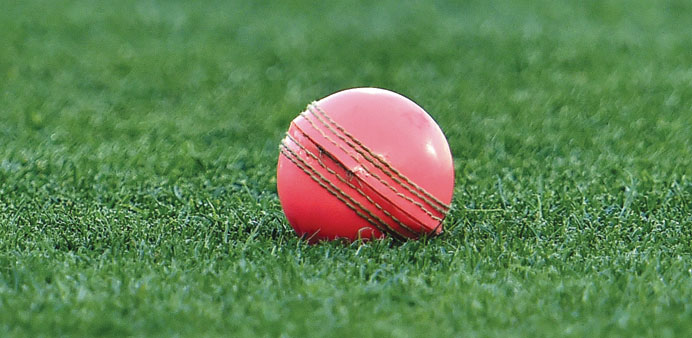Pink revolution? A pink cricket ball is seen on the Adelaide Oval ground ahead of the first day-night cricket Test match between New Zealand and Australia in Adelaide.
AFP/Adelaide
Rival captains Steve Smith and Brendon McCullum said yesterday they were excited about what the first-ever day-night Test could mean for the future of cricket.
Big crowds will be thronging Adelaide Oval for Friday’s pink-ball third Test between Australia and New Zealand, with the cricket world watching the first day-night match in 138 years of Tests with keen interest.
Just like the advent of one-day internationals in the 1970s and the glitzy Twenty20 format in the last decade, Test cricket stands on the threshold of a game-changer and both skippers are keen to buy into the concept.
Smith, whose Australia team lead the three-Test series 1-0, was also upbeat about creating something new and exciting for the traditional form of the international game.
“We are creating history playing in the first day-night Test, so I’m sure a lot of people are going to be watching around the world and that’s really exciting for world cricket,” he said.
“I think it’s a really exciting concept. I can’t wait to get out and give it a crack. I think the crowds have rolled in. Obviously, the first two Tests were a bit disappointing in terms of crowds.
“There’s some big numbers expected for at least the first three days here. So I think it’s really exciting for us moving forward.”
Ticket sales have been brisk, with a first-day crowd of up to 40,000 expected—compared with 16,000 the last time the two sides met in Adelaide in 2008.
McCullum played down the mystery of batting against the specially-designed pink ball under lights, with expectations of it swinging more in the evening conditions.
Sunset is not until 8:00 pm local time so both teams will only be under the glare of the floodlights for up to one-and-a-half hours each day of the match.
n English cricket will feature a major change to the tradition of the pre-match coin toss to decide which team bats first in 2016, the England and Wales Cricket Board announced on Thursday.
In both tiers of next season’s County Championship, the visiting captain will be given the option of bowling first which, if he chooses to take, will see the toss rendered unnecessary.
A coin will only be spun, as has been cricket’s tradition for over a hundred years, if the visiting captain rejects the chance to bowl first.
The proposal was passed, on the basis of a one-year trial, at an ECB board meeting at Lord’s on Thursday and cricket committee head Peter Wright said the move came about partly as a result of concerns about the development of English spinners.
Rather than home teams now winning the toss and unleashing a seam-heavy attack on a pitch which makes batting hazardous, the away captain will now have the option to intervene.
“It isn’t all about spin,” said Wright. “There has been concern for some years about some Championship pitches. But it is fair to say that the plight of spin bowling in this country brought things into focus.
“Figures showing that spinners bowled only 21.5 per cent of the overs in the 2015 Championship were presented to the committee and we have come to the conclusion that the only way to bring spin bowlers more into the game is to provide better pitches for them to bowl on.
“Of course counties want to win matches, and that generally means taking 20 wickets. That has to be a reason we have seen a lot of pitches that start a bit green and damp, and get better as the game goes on, rather than deteriorating to help the spinners.”



